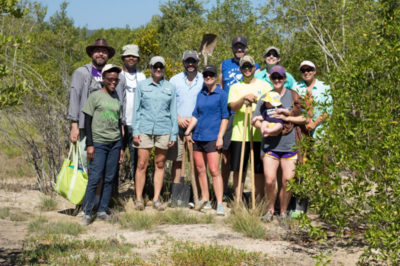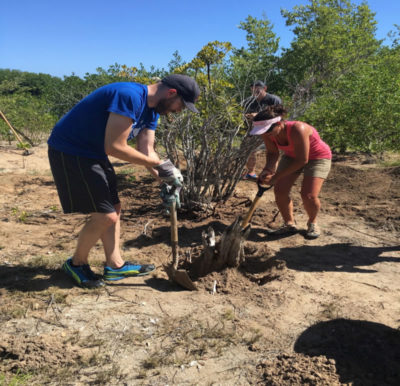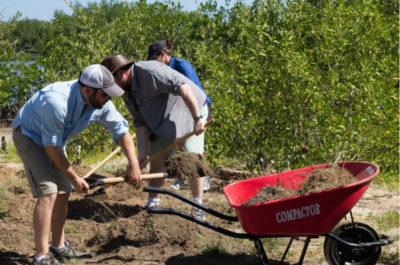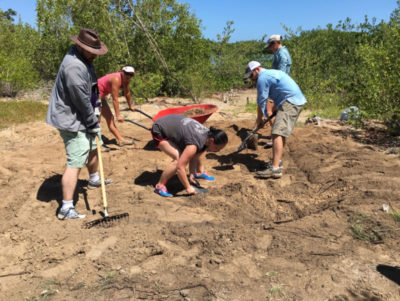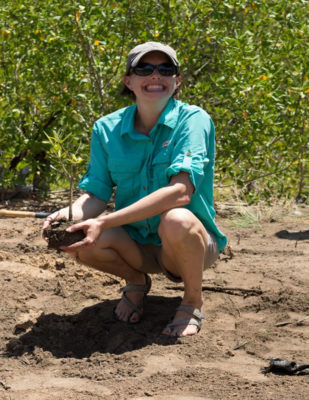LSU School of Renewable Natural Resources Alumni assists with Project JAMIN (Mangrove Restoration Project) during Reunion in Jamaica
A guest blog written by the ‘LSU Wildlife Crew’ who accompanied the KSLOF Education Director to Jamaica for this last phase of the Jamaica Awareness of Mangroves in Nature (J.A.M.I.N.) program.
Mangrove Education and Restoration Program Blog
When you think of a Jamaican vacation, I bet spending a couple hours doing manual labor in a muddy degraded mangrove forest isn’t likely to make your top-ten list of things to do. In short – it wasn’t on our list either, but fate and a shared interest in conservation, ecology, and environmental outreach made for a memorable experience working with Project JAMIN in May of 2016.
Prior to our trip, a blind email to the University of the West Indies Discovery Bay Marine Lab (DBML) hit its mark. I asked about the lab’s current research projects and expressed interest in learning about ecological challenges that researchers are facing in Jamaica. As fate would have it, the DBML’s Chief Scientific Officer Camilo Trench made us an offer we couldn’t refuse – to assist with a mangrove restoration and outreach project named Project J.A.M.I.N.
Considering most of our group consisted of Natural Resource Professionals that graduated from Louisiana State University’s School of Natural Resources between 2006-2009, this opportunity fit us perfectly. Collectively, we represented careers spanning Wildlife, Fisheries, Environmental Science, African Wildlife Conservation, and Coastal Ecology. Not only do we share a passion for conservation science but also for outreach projects that educate others and highlight conservation issues.
When we pulled up to the restoration site, it was not the pretty beaches or blue-green water we had come to Jamaica to enjoy; it was a hot, humid, damaged mangrove forest. We listened intently as Mr. Trench explained how locals cut and burn mangrove trees to create charcoal. Aside from the obvious removal of the plant itself, the dirt mounds left behind also alter hydrology and impede natural mangrove reestablishment. Although this was our first time learning about habitat degradation in Jamaica, our group has worked with other habitat loss issues in parts of the US Gulf Coast. Similar to the mangrove issue here at this site, wetland loss due to changes in hydrology and human alterations is a big topic in South Louisiana – one that’s obviously close to our hearts. Just as we have a passion to see our Louisiana coastline restored and protected, Mr. Trench and Amy Heemsoth of the Khaled bin Sultan Living Oceans Foundation share that same mission here in Jamaica.
Amy and Mr. Trench explained our goal for the day: restore a small site containing a large mound that was obviously impacting the hydrology of the area. While the tidal waters where only feet away at high tide, the mounds created by the charcoaling activity restricted water movement and it was our goal to fix it! Armed with a couple shovels, rakes, a pick-ax, and wheelbarrow, we hashed out a plan and began removing invasive vegetation and excess soil. In the next few hours we made our mark on that small swath of ground and returned it back to it’s natural elevation. Finally, we carefully planted the mangrove propagules that Mr. Trench had grown back at the lab.
Noted ecologist Aldo Leopold once said, “A conservationist is one who is humbly aware that with each stroke [of the axe] he is writing his signature on the face of the land.” Considering the mangroves were removed by the very tool that Leopold speaks of, projects like J.A.M.I.N. help rewrite those signatures and replace them with a legacy of care and concern for our environment and natural resources. Although our group did not get to personally meet the students of Project J.A.M.I.N., we hope they understand the significance of their contributions in restoring this site. Undoubtedly, the actions taken by the students will have a positive impact on this community. We hope the students will take pride in their work and share their experience. Know that our group faces similar challenges in a world away, but the process to recovery is the same: identify the problem, find a solution, educate the people, and get the people involved in the solution – just like J.A.M.I.N. We thank Amy and the Khaled bin Sultan Living Oceans Foundation for their vision and dedication, thank Mr. Trench and the DBML for their experience and knowledge, and thank the students of Project J.A.M.I.N for stepping up and making a difference.
– Best Wishes from the LSU Wildlife Crew
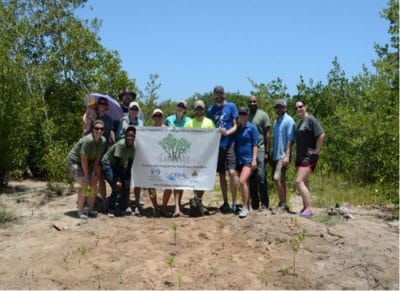
Heather Brand (BS 06’, Conservation Biologist) and Husband Matt Trumbull
Tamra Dardenne (BS 06’ Environmental Tech)
Ann Commagere Hijuelos (BS/MS 06’/12’ Coastal Ecologist) and Husband Jason Hijuelos
Kayla Dibenedetto Kimmel (BS/MS 06’/09’ Fisheries Biologist)
Tim Kimmel (BS/MS 08’/10’ Environmental Scientist)
Lauren Hart Thayer (BS 08’ Environmental Specialist)
Justin Wilder Thayer (BS/MS 06’/09’ Wildlife Biologist)
Rachel Villani (BS/MS 07’/10’ Coastal Ecologist)


